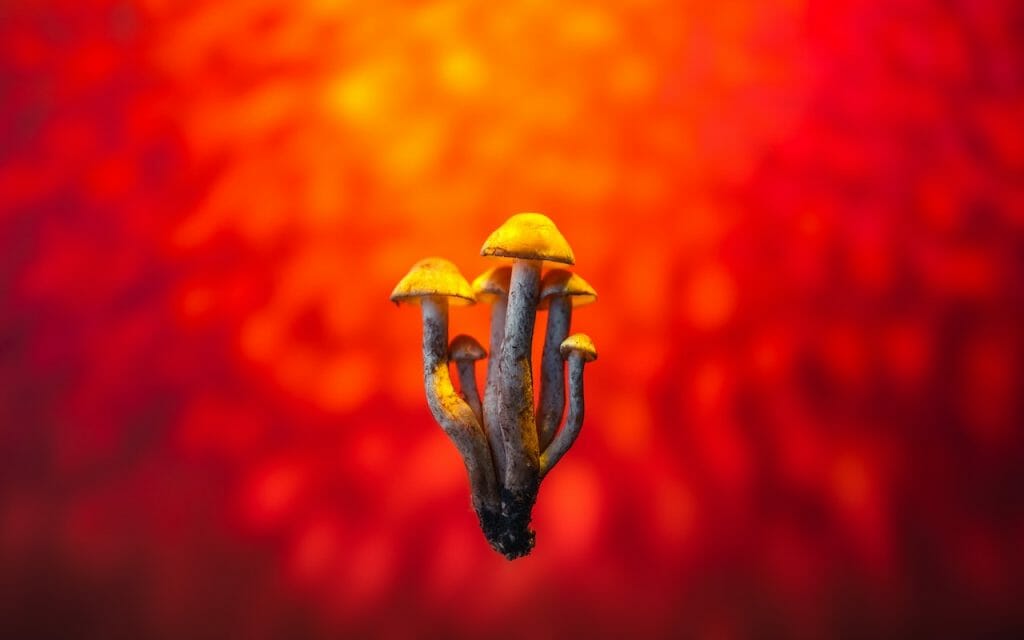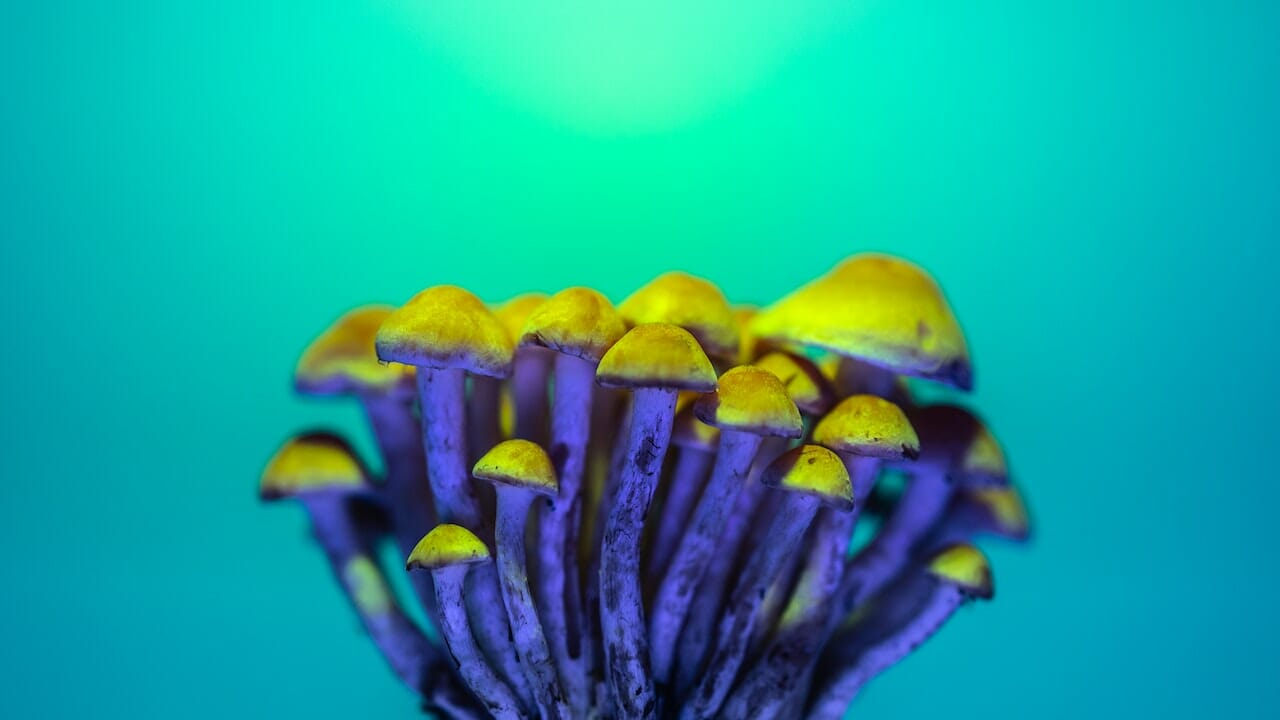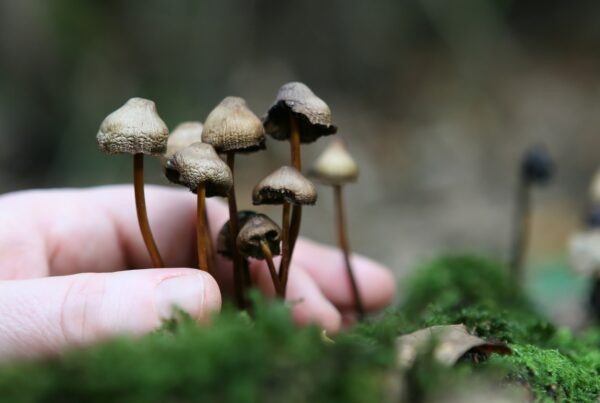Lysergic Acid Diethylamide (LSD) is a remarkably potent hallucinogen, and it’s among the most thoroughly studied psychedelic substances. Initially associated predominantly with recreational usage, LSD has evolved into a psychoactive compound with potential mental health benefits. This perception shift has provided new avenues for exploring the effects of LSD in more palatable forms such as LSD edibles.
Key Takeaways:
- LSD, a powerful hallucinogen, originates from the ergot fungus.
- LSD shares similarities with psilocybin and interacts with 5-HT2A receptors.
- Known effects of LSD include altered visuals, mood swings, ego dissolution, and pseudo-hallucinations.

Getting to Know LSD
LSD is an extraordinarily potent hallucinogen capable of significantly altering the user’s perception of reality and considerably distorting the senses. LSD originates from “ergot“, a fungus typically found on rye and other grains.
At its molecular level, LSD is a complex chemical belonging to the ergoline family. It comprises a bicyclic hexahydroindole group and a bicyclic quinoline group (lysergic acid). The term ‘Lysergic Acid Diethylamide’ derives from the functional group attached to its core. The LSD structure is akin to other ergoline alkaloids such as ergotamine, present in the ergot fungus Claviceps purpurea, and the neurotransmitter serotonin.
The Effects of LSD
Upon consumption, LSD enters the brain, instigating chemical reactions that can endure for numerous hours. LSD may lead to the following short-term effects:
- Unforeseen mood alterations
- Distorted perception
- Feeling dizzy
- Decreased appetite
- Difficulty in movement control
The Benefits What are the beneficial effects of LSD?
LSD offers a variety of benefits, with the extent of these benefits largely dependent on the dose taken. The majority of studies have examined the positive impacts associated with smaller doses of this psychedelic substance. In the following sections, we explore the positive outcomes linked to LSD consumption.
Pain Relief and Neurological Development
Research conducted at Maastricht University has revealed that a single microdose of LSD can produce analgesic effects that persist for a minimum of five hours.
During the Cold Pressor Test, where participants are asked to keep their hands in 3°C (37.4°F) water for as long as possible, individuals who consumed 20 mg of LSD demonstrated a 20% increase in their endurance. They also reported experiencing reduced pain and discomfort.
Furthermore, LSD has been shown to support the development and growth of the brain’s 86 billion neurons. Moderate doses of LSD, ranging from 5 to 20 ug, increase the levels of BDNF in blood plasma. This is noteworthy as mood disorders such as depression, often associated with neuroplasticity problems, may see improvement due to LSD’s beneficial effects on neuronal health.
Improvement of Mental Health
Dr. Robin Carhart-Harris from Imperial College London introduced the entropic brain hypothesis. This concept proposes that mental health issues originate from rigid thought patterns, perpetuated by an overactive default mode network (DMN). Psychedelics like LSD can disrupt the DMN, enhance brain entropy, and promote the dissolution of harmful neural pathways while fostering the creation of beneficial ones.
A study involving more than 1,000 participants who microdosed reported a decrease in depression. A separate large-scale study indicated a reduction in negative moods and harmful attitudes, coupled with an increase in open-mindedness and cognitive function.
Addiction Treatment
A comprehensive analysis of randomized-controlled clinical trials utilizing LSD in psychiatry determined it to be highly effective in treating alcohol dependency. This conclusion is further bolstered by the successful treatment of many patients suffering from alcoholism by Humphrey Osmond and at the Spring Grove Hospital Centre during the 1950s and 1960s.
Easing End-of-Life Anxiety and Depression
Dr. Peter Gasser discovered that LSD-enhanced psychotherapy can aid terminally ill cancer patients in managing their end-of-life anxiety. They also reported an improved sense of life quality. Currently, a Phase 2 trial is underway to explore the potential influence of LSD therapy on depression.
Decoding LSD Edibles: Their Ingredients and Manufacturing Process
LSD edibles are a category of food and beverage items infused with the psychedelic substance, LSD. These edibles come in various forms, from chocolates, candies, and baked goods, to unique items like LSD mints.
The Ingredients
- LSD: This is the active component that triggers psychedelic effects. It is carefully measured and incorporated into the edible.
- Edible Base: The LSD is usually dissolved or infused into an edible medium like a gummy, candy, sugar cube, or other ingestible items. These mediums act as the delivery method for the psychedelic compound.
- Flavouring and Ingredients: The specific edible product may contain flavourings, sweeteners, and other ingredients to enhance the taste and texture. These could include natural or artificial flavourings, colouring agents, and sugars, and can vary widely.
Manufacturing Process:
- LSD Synthesis: The primary step involves the chemical production of LSD. This procedure requires extensive knowledge of organic chemistry and access to the necessary chemicals, equipment, and a laboratory environment.
- Liquid Formulation: Once the LSD is synthesized, it’s typically transformed into a liquid form by dissolving it in a solvent. This liquid acts as a concentrated LSD solution.
- Infusion: The liquid LSD is then infused into an edible medium such as gummy candies, sugar cubes, or blotter paper. The infused medium absorbs the liquid, enabling the LSD to be consumed orally.
Experiencing the Psychedelic Effects of Psychoactive Compounds in LSD Edibles
LSD triggers dramatic visual effects. Colours appear more intense, objects may seem to have halos or rainbows around them, and shapes can transform. Whether the eyes are open or closed, users may see
LSD can alter one’s perception of themselves and their environment, inducing a variety of mental states. Thoughts may appear clear and meaningful, or they may seem disjointed. Other effects may include alterations in how time, distance, and self-image are perceived. The boundary between oneself (the ego) and the external world may appear indistinct. Some users report synesthesia-like experiences, such as visually perceiving music or hearing colours.
Suggested LSD Products
While there are many LSD-infused edibles available, it’s imperative to purchase from a reliable dispensary. It’s important to verify that the edibles contain LSD and not other substances like PCP, ecstasy, or ketamine.
Deadhead Chemist – LSD Infused Gummies
Deadhead Chemist offers LSD-infused edibles, each with 100 micrograms (ug) of LSD, in a range of flavours. Each package includes a single gummy, which has shown potential in aiding individuals with conditions such as obsessive-compulsive disorder (OCD), post-traumatic stress disorder (PTSD), alcoholism, depression, and cluster headaches.
Deadhead Chemist – Mint Tea
Deadhead Chemist’s raspberry mint tea presents a tastier and more flavour-filled way to experience the effects of LSD. LSD and other psychedelics imitate the serotonin neurotransmitter, enhancing the brain’s flow state.
Earthly Delights – Candy Flips
Candy flipping emerged during the rave culture of the late 1980s and continues to be enjoyed by thrill-seekers and party-goers today. Users often experience intense feelings of love and unity, along with captivating visual effects such as colour enhancement, object morphing, and complex geometric patterns.
Concluding Remarks
LSD has a historic connection with transformative experiences. As the scientific comprehension of this substance has grown, its popularity has skyrocketed, leading to the advent of edible LSD products. Such appetizing delights have opened a new pathway for individuals.
Experience LSD safely and pleasurably with controlled dosages.
As the leading provider in Canada of high-grade online shrooms, Funguyz Canada offers an extensive variety of LSD-infused edibles and cannabis products. Explore our selection at your convenience, add your chosen products to your cart, and sit back at home as we handle the delivery. We also offer an array of psilocybin shrooms, edibles, drinks, and capsules for your convenience. Be sure to check out our LSD delivery page for additional details!
Frequently Asked Questions
How does LSD differ from psilocybin?
FEATURES LSD PSILOCYBIN Source Semi-synthetic chemical compound Occurs naturally in fungi Possible Forms Tabs, microdots, liquid, gummies, blotter paper Dried mushrooms, capsules, teas, chocolates Potency Highly potent, microgram doses (ug) Depends on the species of mushrooms and their preparation Onset and Duration Quick onset (15-60 minutes), short duration (3-5 hours) Gradual onset (30-60 minutes), moderate duration (4-6 hours)
How can one avoid negative experiences with LSD?
- Choose Your Surroundings Wisely
- Set Your Mindset
- Start with a Small Dose
- Arrange for a Trip Supervisor
- Create a Peaceful Environment
- Use Deep Breathing and Grounding Techniques
- Accept and Release
How long do the effects last?
The effects of the acid will begin to show between 30-60 minutes after ingestion. Individuals with a greater sensitivity to psychedelics may start to feel the effects In just a quarter of an hour, you’ll be able to discern if you’ve consumed acid. Roughly an hour later, you’ll reach the pinnacle of your trip. During this experience, it may feel like time is standing still and you might start to experience hallucinations.
Don’t worry if you start feeling detached from reality during this phase. This is quite normal. The peak phase will last anywhere from 3 to 5 hours, followed by the offset phase which will continue for an additional 3 to 5 hours.
How does LSD interact with the human body?
LSD primarily works by interacting with the brain’s serotonin system. It binds to and stimulates the 5-HT2A receptor, which sets off a chain of neurochemical and physiological reactions. The effects of LSD can vary widely, influenced by several factors.
Are there other types of LSD besides edibles?
Yes, there are. LSD is available in a variety of formats. The four primary types of LSD products are blotter paper, liquid solutions, tablets/microdots, and gelatin sheets.
Suggested Readings:
| FEATURES | LSD | PSILOCYBIN |
| Source | Semi-synthetic chemical compound | Occurs naturally in fungi |
| Possible Forms | Tabs, microdots, liquid, gummies, blotter paper | Dried mushrooms, capsules, teas, chocolates |
| Potency | Highly potent, microgram doses (ug) | Depends on the species of mushrooms and their preparation |
| Onset and Duration | Quick onset (15-60 minutes), short duration (3-5 hours) | Gradual onset (30-60 minutes), moderate duration (4-6 hours) |





